Themed collection Fluorescent and Luminescent Materials

Solid-state fluorescent carbon dots: quenching resistance strategies, high quantum efficiency control, multicolor tuning, and applications
In this review, comprehensive overview about solid-state fluorescent CDs is given, with especial emphasis on the strategies for quenching-resistance, the methods for high quantum efficiency, the methods for multicolor tuning and their application.
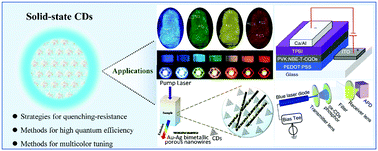
Mater. Adv., 2020,1, 3122-3142
https://doi.org/10.1039/D0MA00632G
Near-infrared fluorescent protein and bioluminescence-based probes for high-resolution in vivo optical imaging
This review presents the recent progress on NIR fluorescent protein and bioluminescence-based probes with high-resolution in vivo imaging techniques.
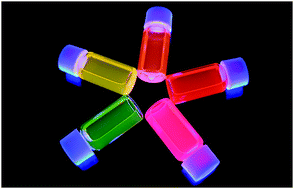
Mater. Adv., 2020,1, 967-987
https://doi.org/10.1039/D0MA00273A
Earth abundant colloidal carbon quantum dots for luminescent solar concentrators
We reviewed the synthetic strategies, structure and properties of C-dots, and summarized the recent progress of C-dots based luminescent solar concentrators.

Mater. Adv., 2020,1, 119-138
https://doi.org/10.1039/D0MA00181C
Signal transmission encryption based on dye-doped chiral liquid crystals via tunable and efficient circularly polarized luminescence
Multi-channel adjustable CPL in chiral liquid crystals was investigated, where a well-organized structure distributed in double thin layers exhibits a high |glum| for the input signal to encrypt information transmission.

Mater. Adv., 2021,2, 3851-3855
https://doi.org/10.1039/D1MA00368B
L-Tyrosine derived fluorescent molecular probes as solvent mediated flip-flop halide (iodide/fluoride) sensors and reversible chromogenic pH indicators
We report the use of L-tyrosine derived probes (H2Tyr-4-nitro/H2Tyr-3-nitro) for solvent mediated differential flip-flop sensing of fluoride and iodide and as reversible optical pH indicators.
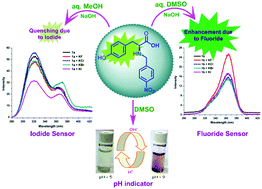
Mater. Adv., 2021,2, 942-947
https://doi.org/10.1039/D0MA00589D
Facile in situ formation of luminescent cellulose paper using Schweizer's reagent as an inorganic solvent in water
The inorganic solvent Schweizer reagent was attached to the surface of cellulose, followed by an in situ chemical reaction performed directly on the solvent forming a stable and luminescent Cu(I) cluster-functionalized cellulose paper.
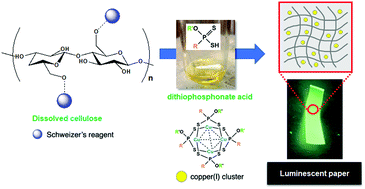
Mater. Adv., 2020,1, 1055-1060
https://doi.org/10.1039/D0MA00135J
Which is a better fluorescent sensor: aggregation-induced emission-based nanofibers or thin-coating films?
Aggregation-induced emission (AIE)-based fluorescent nanofibers (FNFs) and thin-coating films (FTFs) are employed as visual fluorescent sensors, and their performance dynamics is compared.
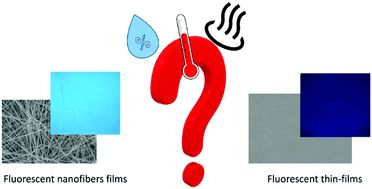
Mater. Adv., 2020,1, 574-578
https://doi.org/10.1039/D0MA00409J
Energy transfer-triggered multicolor emissions in Tb3+/Eu3+-coactivated Y2Mo3O12 negative thermal expansion microparticles for dual-channel tunable luminescent thermometers
Through the introduction of Tb3+ and Eu3+ ions into YMO, the designed NTE microparticles can not only emit bright multicolor emissions but also exhibit promising applications in optical thermometry.
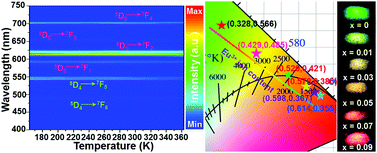
Mater. Adv., 2021,2, 4824-4831
https://doi.org/10.1039/D1MA00218J
Asymmetric D–A–D′ Scaffold inducing distinct mechanochromic luminescence
Two novel distinct multi-stimuli responsive mechanochromic luminescence (MCL) materials were prepared with an asymmetric D–A–D′ scaffold.
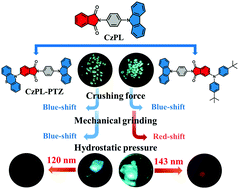
Mater. Adv., 2021,2, 4859-4866
https://doi.org/10.1039/D1MA00296A
Regulating the Bi NIR luminescence behaviours in fluorine and nitrogen co-doped germanate glasses
The structure of the germanate glasses was depolymerized by introducing different types of alkaline earth metal fluorides from MgF2 to BaF2, which resulted in different luminescence behaviours of Bi-related NIR centers.

Mater. Adv., 2021,2, 4743-4751
https://doi.org/10.1039/D1MA00395J
Nontoxic photoluminescent tin oxide nanoparticles for cell imaging: deep eutectic solvent mediated synthesis, tuning and mechanism
Deep eutectic solvents as versatile green media for the synthesis of non-toxic photoluminescent tin oxide nanoparticles with potential applications demonstrated in cell imaging and as antioxidants.

Mater. Adv., 2021,2, 4303-4315
https://doi.org/10.1039/D1MA00042J
Graphitic carbon nitride embedded-Ag nanoparticle decorated-ZnWO4 nanocomposite-based photoluminescence sensing of Hg2+
Ag loaded metal tungstate-organic framework-based nanocomposite (g-C3N4/Ag/ZnWO4), which generates greater number of oxygen defects plays crucial role in the selective detection of toxic metal ions in solution.
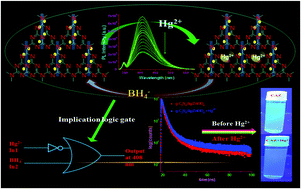
Mater. Adv., 2021,2, 4041-4057
https://doi.org/10.1039/D1MA00211B
Photoluminescence and electroluminescence characterization of high-performance near-infrared emitters based on 1,5-naphthyridin-4-ol-containing heteroleptic platinum(II) complexes
Four 1,5-naphthyridin-4-ol-containing platinum complexes, AtFOND, AtFNND, PBSOND, and PBSNND, have been synthesized and characterized for their photoluminescence (PL) and electroluminescence (EL) properties.

Mater. Adv., 2021,2, 3589-3599
https://doi.org/10.1039/D1MA00141H
Eu3+-functionalized CQD hybrid material: synthesis, luminescence properties and sensing application for the detection of Cu2+
We develop a novel flexible method to construct a lanthanide dual-emitting ratiometric fluorescence nanoprobe with excellent luminescence properties and significantly selectivity for the detection of copper ions.

Mater. Adv., 2021,2, 3346-3352
https://doi.org/10.1039/D1MA00059D
MEMS-compatible, gold nanoisland anchored 1D aligned ZnO heterojunction nanofibers: unveiling the NO2 sensing mechanism with operando photoluminescence studies
Single step, on-chip fabrication of 1D aligned Au functionalized heterojunction ZnO nanofibers via coaxial electrospinning with in situ photoreduction has been demonstrated.
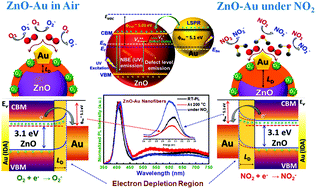
Mater. Adv., 2021,2, 3000-3013
https://doi.org/10.1039/D1MA00094B
Negative thermal expansion triggered anomalous thermal upconversion luminescence behaviors in Er3+/Yb3+-codoped Y2Mo3O12 microparticles for highly sensitive thermometry
Thermally enhanced UC emission is observed in Er3+/Yb3+-codoped Y2Mo3O12 NTE microparticles and they are pormising candidates for optical thermometry.

Mater. Adv., 2021,2, 2642-2648
https://doi.org/10.1039/D1MA00072A
A family of luminescent metal–organic frameworks: synthesis, structure, and sensing studies
Herein we report three novel luminescent metal–organic frameworks (MOFs) viz. [Co(bpeb)(hfipbb)0.5]n (LCo-1), [Zn(bpeb)2(hfipbb)]n (L-Zn) and [Co(bpeb)2(oba)]n (LCo-2) which were synthesized through the solvothermal method and characterized by SC-XRD.

Mater. Adv., 2021,2, 2667-2675
https://doi.org/10.1039/D0MA00889C
Quinoline-tagged fluorescent organic probes for sensing of nitro-phenolic compounds and Zn2+ ions at the ppb level
The effect of flexible tetra-methylene vs. semi-rigid xylylene spacers appended in two quinoline tagged sensors bqbpbn (1) and bqbpxn (2) on the sensing of nitro-phenolic compounds and metal ions has been demonstrated.
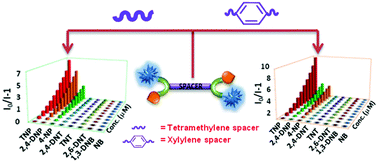
Mater. Adv., 2021,2, 2334-2346
https://doi.org/10.1039/D1MA00025J
Mn2+ activated Ca-α-SiAlON – broadband deep-red luminescence and sensitization by Eu2+, Yb2+ and Ce3+
Mn2+ occupies [Ca(N,O)7] polyhedral site in Ca-α-SiAlON. The polyhedral site imposes stronger crystal field and nephelauxetic shift on Mn2+ 4T1 → 6A1 transition, leading to an intense and broad deep-red emission.
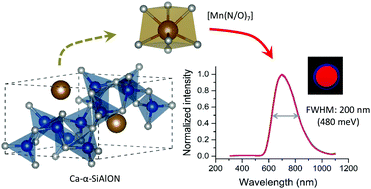
Mater. Adv., 2021,2, 2075-2084
https://doi.org/10.1039/D1MA00036E
Defect clustering in an Eu-doped NaMgF3 compound and its influence on luminescent properties
We combined classical atomistic simulation and crystal field models to describe the origin of defects and their influence on luminescent properties of Eu-doped NaMgF3 in the orthorhombic phase.
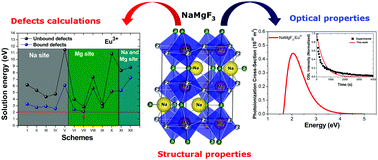
Mater. Adv., 2021,2, 1378-1389
https://doi.org/10.1039/D0MA00953A
The impact of lipid head-groups in GUVs on electron transfer by surface-adsorbed fluorescent gold nanoclusters
The ligand-to-metal charge transfer in gold nanoclusters gets influenced by the interacting lipid that regulates photoinduced electron transfer in the aqueous medium.
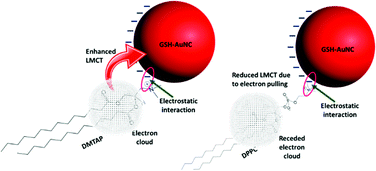
Mater. Adv., 2021,2, 1343-1350
https://doi.org/10.1039/D0MA00930J
Multiple “Hot exciton” channel molecular design in organic electroluminescence materials: a theoretical investigation
One “Hot exciton” channel is expanded into multiple channels through molecular design, which improves the efficiency of RISC.

Mater. Adv., 2021,2, 1351-1357
https://doi.org/10.1039/D0MA00927J
Alkylamine screening and zinc doping of highly luminescent 2D tin-halide perovskites for LED lighting
Highly luminescent and stable two-dimensional tin-halide perovskites for LED lighting applications were achieved through alkylamine screening and zinc doping.
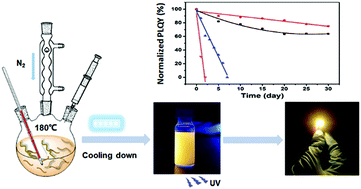
Mater. Adv., 2021,2, 1320-1327
https://doi.org/10.1039/D0MA00845A
A selective detection of nanomolar-range noxious anions in water by a luminescent metal–organic framework
A Tb-doped Y-based MOF was constructed for simultaneous recognition of noxious anions HAsO42−, PO43−, MnO4−, CrO42− and Cr2O72− in water.
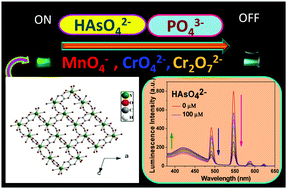
Mater. Adv., 2021,2, 985-995
https://doi.org/10.1039/D0MA00811G
Molecular structure controlled self-assembly of pyridine appended fluorophores: multi-stimuli fluorescence responses and fabricating rewritable/self-erasable fluorescent platforms
Pyridine appended structural isomers showed a planar or propeller conformation dependent molecular self-assembly, fluorescent polymorphs, stimuli-responsive fluorescence switching and halochromism.

Mater. Adv., 2021,2, 996-1005
https://doi.org/10.1039/D0MA00736F
Cyclic siloxanes conjugated with fluorescent aromatic compounds as fluoride sensors
When cyclic siloxanes were exposed to fluoride ions, a blue-shift and enhanced fluorescence emissions appeared in most organic solvents.
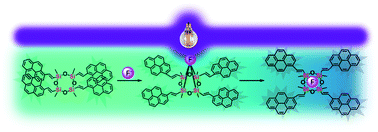
Mater. Adv., 2020,1, 3358-3368
https://doi.org/10.1039/D0MA00476F
Luminescent molecular switches based on dicationic P-doped polycyclic aromatic hydrocarbons
We report the efficient synthesis cationic P-doped Polycyclic Aromatic Hydrocarbons showing electrofluorochromic properties.

Mater. Adv., 2020,1, 3369-3377
https://doi.org/10.1039/D0MA00711K
Nitrogen and sulfur co-doped fluorescent carbon dots for the trapping of Hg(II) ions from water
An uncomplicated, reliable, and ultrasensitive fluorescent carbon dots (CDs) co-doped with nitrogen and sulfur atoms based sensor has been fabricated for the recognition and trapping of toxic Hg2+ in buffered aqueous medium and real water samples.
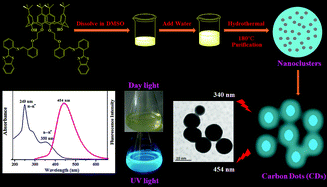
Mater. Adv., 2020,1, 3009-3021
https://doi.org/10.1039/D0MA00448K
Electrospray-based synthesis of fluorescent poly(D,L-lactide-co-glycolide) nanoparticles for the efficient delivery of an anticancer drug and self-monitoring its effect in drug-resistant breast cancer cells
A novel approach used to synthesize antimetabolite-conjugated and intense blue fluorescence-emitting smart polymeric nanoparticles is reported for the efficient delivery of anticancer drugs and self-monitoring their effect in drug-resistant metastatic breast cancer cells.
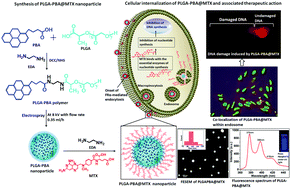
Mater. Adv., 2020,1, 3033-3048
https://doi.org/10.1039/D0MA00646G
Tris(triazolo)triazine-based emitters for solution-processed blue thermally activated delayed fluorescence organic light-emitting diodes
We report a new emitter 3,4,5-3TCz-TTT based on a tris(triazolo)triazine acceptor that shows thermally activated delayed fluorescence and cross-compare its performance with the recently reported analogue, 3DMAC-TTT.

Mater. Adv., 2020,1, 2862-2871
https://doi.org/10.1039/D0MA00659A
Luminescence in external dopant-free scandium-phosphorus vanadate solid solution: a spectroscopic and theoretical investigation
Manipulating the high valence secondary P5+/V5+ ions in the external dopant-free Sc(Px,V1−x)O4 (0.0 ≤ x ≤ 1.0) solid solution enables resulting in the spectral tuning, enhanced photoluminescence (PL) intensity, and improved thermally induced PL quenching stability.
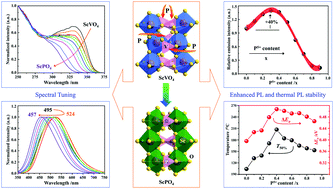
Mater. Adv., 2020,1, 2467-2482
https://doi.org/10.1039/D0MA00438C
A novel NIR fluorescent probe for fast detection and imaging of methionine sulfoxide reductase A in lysosome of living cells
A novel lysosome-targeted NIR fluorescent probe for fast detection and imaging Msr A was developed by extending the linear π-conjugated system of the probe via SNArH reaction.

Mater. Adv., 2020,1, 2401-2406
https://doi.org/10.1039/D0MA00489H
Crystal structure, luminescence properties and application performance of color tuning Y2Mg2Al2Si2O12:Ce3+,Mn2+ phosphors for warm white light-emitting diodes
The CCT of phosphor-converted WLEDs achieved effective optimization by a co-doping and energy transfer strategy applied to the phosphors.
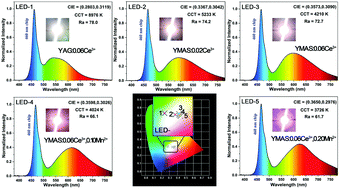
Mater. Adv., 2020,1, 2261-2270
https://doi.org/10.1039/D0MA00556H
Highly sensitive and precise optical temperature sensors based on new luminescent Tb3+/Eu3+ tetrakis complexes with imidazolic counterions
Precise optical temperature sensors based on luminescent Tb3+:Eu3+ tetrakis complexes with imidazolic counterions with high emission quantum yield values and low temperature uncertainty.
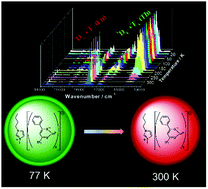
Mater. Adv., 2020,1, 1988-1995
https://doi.org/10.1039/D0MA00201A
A rational design of a cancer-specific and lysosome-targeted fluorescence nanoprobe for glutathione imaging in living cells
A dual-targeting (both cancer cell- and lysosome-targeting) fluorescence nanoprobe was rational designed and synthesized for the efficient imaging of lysosomal GSH in cancer cells.
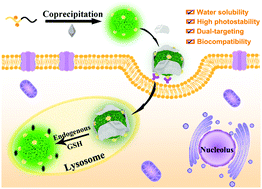
Mater. Adv., 2020,1, 1739-1744
https://doi.org/10.1039/D0MA00124D
Luminescence and luminescence quenching of K2Bi(PO4)(MoO4):Sm3+ phosphors for horticultural and general lighting applications
Novel and highly thermally stable K2Bi(PO4)(MoO4):Sm3+ phosphors were prepared and used to produce pcLEDs for horticulture and general lighting application.
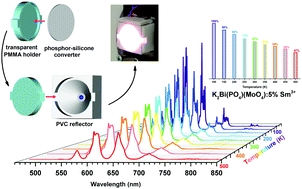
Mater. Adv., 2020,1, 1427-1438
https://doi.org/10.1039/D0MA00369G
Lysozyme coated copper nanoclusters for green fluorescence and their utility in cell imaging
Green fluorescent, pH dependent and water soluble copper nanoclusters (3–5 nm) were synthesized by stabilizing with lysozyme and these were demonstrated for imaging in both healthy and cancer cell lines as an alternate to green fluorescent protein.

Mater. Adv., 2020,1, 1439-1447
https://doi.org/10.1039/D0MA00386G
Perylene diimide-based supramolecular polymer with temperature-sensitive ratiometric fluorescence responsiveness in solution and gels
The quadruple hydrogen bonding UPy units are designed to conjugate with unsubstituted PDI to exhibit bright red emission in aggregated state, together with temperature-dependent ratiometric fluorescence property in solution and hydrogels.

Mater. Adv., 2020,1, 1330-1336
https://doi.org/10.1039/D0MA00053A
Investigation of the photoluminescence and novel thermoluminescence dosimetric properties of NaGdF4:Tb3+ phosphors
Photoluminescence and novel thermoluminscence studies of the NaGdF4:Tb3+ phosphor.

Mater. Adv., 2020,1, 1113-1124
https://doi.org/10.1039/D0MA00247J
Luminescent poly(dendrimer)s for the detection of explosives
Poly(dendrimer)s have a larger response compared to their corresponding monomers for the detection of trace quantities of nitro-based explosives.
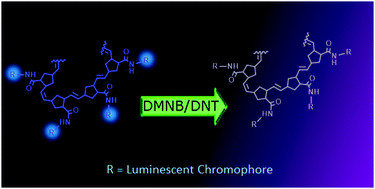
Mater. Adv., 2020,1, 837-844
https://doi.org/10.1039/D0MA00249F
Luminescent hybrid coatings prepared by a sol–gel process for a textile-based pH sensor
Luminescent hybrid materials which contain fluorene and stilbene based fluorophores were coated onto cotton fabrics to design textile-based pH sensors.
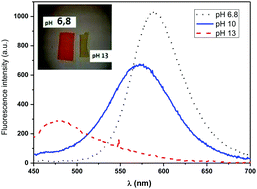
Mater. Adv., 2020,1, 918-925
https://doi.org/10.1039/D0MA00211A
Synthesis, fluorescence property and cell imaging of a perylene diimide-based NIR fluorescent probe for hypochlorite with dual-emission fluorescence responses
In this study, for the first time, a novel near-infrared and ratiometric fluorescent probe was conveniently synthesized by reacting PDI-based salicylaldehyde with 2-(hydrazonomethyl)phenol.

Mater. Adv., 2020,1, 814-819
https://doi.org/10.1039/D0MA00131G
Two types of two-step mechanochromic luminescence of phenanthroimidazolylbenzothiadiazoles
Two types of two-step mechanochromic luminescence (MCL) as well as bicolor MCL have been achieved by changing the R substituent.

Mater. Adv., 2020,1, 708-719
https://doi.org/10.1039/D0MA00198H
Ultrafast scale-up synthesis of calcium rod/layer MOFs and luminescence detection of water in organic solvents
General applicability of the ultrafast scale-up synthesis of Ca–MOFs that are inexpensive, eco-friendly and practically useful, is demonstrated.

Mater. Adv., 2020,1, 689-697
https://doi.org/10.1039/D0MA00038H
Triphenylamine-imidazole-based luminophores for deep-blue organic light-emitting diodes: experimental and theoretical investigations
Solution-processable multilayer OLEDs were fabricated by employing the blue luminophores as dopants in the 4,4′-bis(9H-carbazol-9-yl)biphenyl (CBP) host and were found to exhibit bright deep blue electroluminescence with high efficiency.
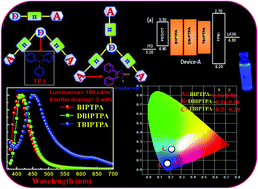
Mater. Adv., 2020,1, 666-679
https://doi.org/10.1039/D0MA00007H
Development of fluorescent sensors based on a combination of PET (photo-induced electron transfer) and FRET (Förster resonance energy transfer) for detection of water
Fluorescent sensors DJ-1 and DJ-2 with a large Stokes shift (SS) based on a combination of photo-induced electron transfer (PET) and Förster resonance energy transfer (FRET) for the detection of water in solvents have been developed.
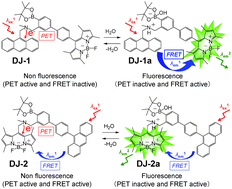
Mater. Adv., 2020,1, 354-362
https://doi.org/10.1039/D0MA00139B
Donor and acceptor engineering for BINOL based AIEgens with enhanced fluorescence performance
A D–π–A strategy enhances aggregation-induced emission performance with a large Stokes shift over 200 nm.

Mater. Adv., 2020,1, 61-70
https://doi.org/10.1039/D0MA00022A
About this collection
This article collection highlights some of the most recent articles in Materials Advances exploring fluorescence and luminescence in the context of materials research. Containing both reviews and original research, this collection covers applications including sensing, imaging and lighting.